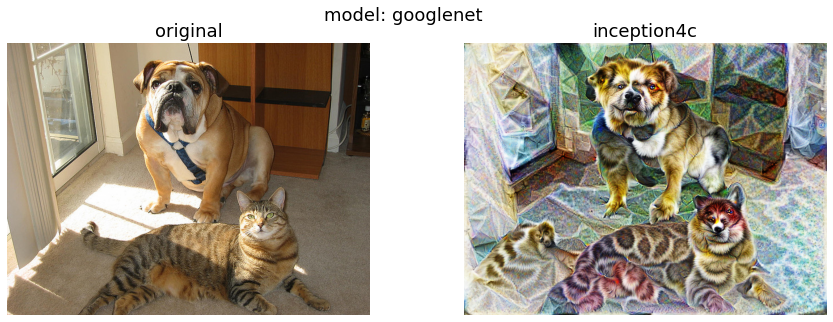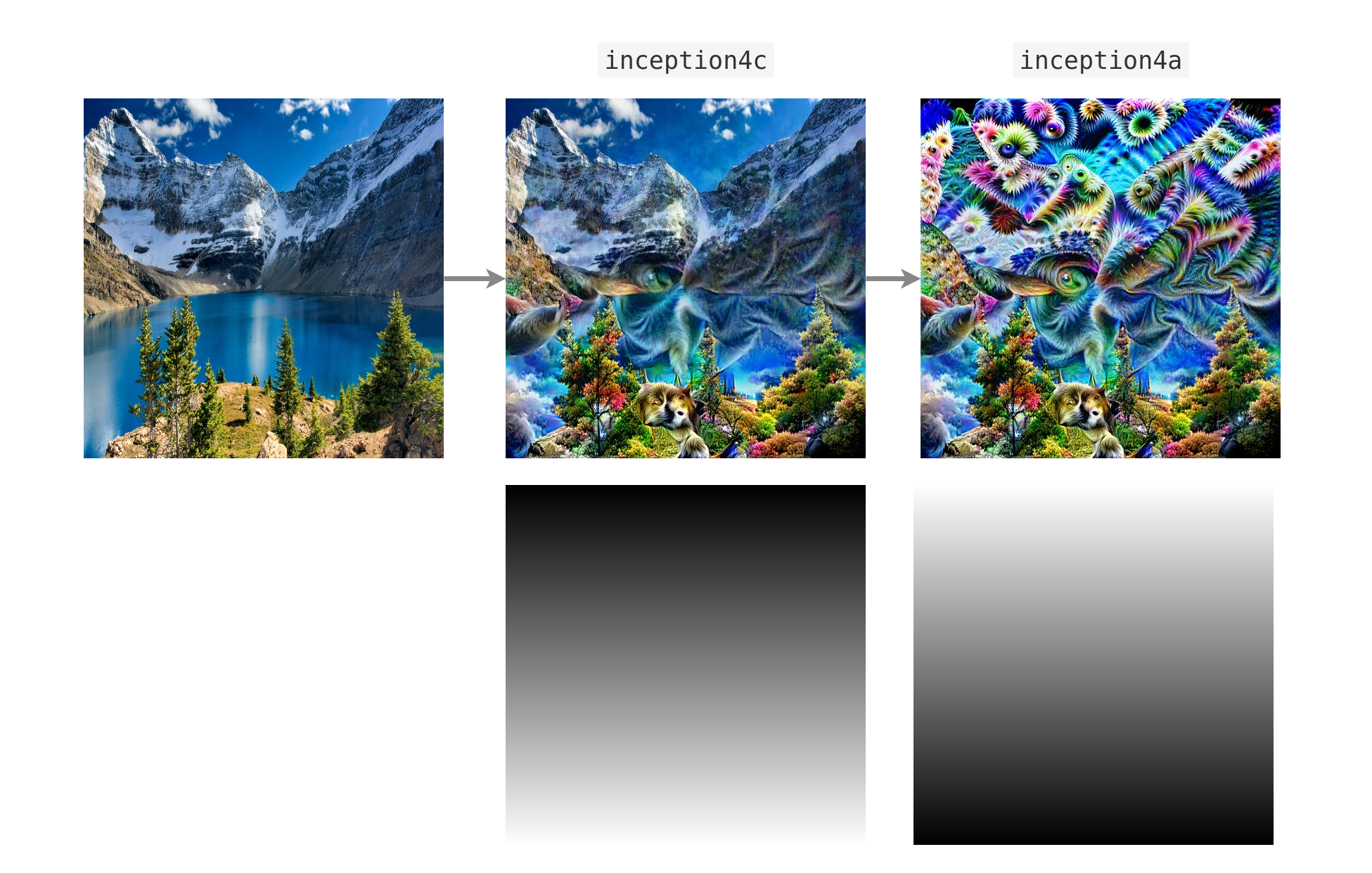https://github.com/mayukhdeb/torch-dreams
Flexible Feature visualization on PyTorch, for research and art :mag_right: :computer: :brain: :art:
https://github.com/mayukhdeb/torch-dreams
colab deep-dream deep-learning feature-visualization pytorch
Last synced: 7 months ago
JSON representation
Flexible Feature visualization on PyTorch, for research and art :mag_right: :computer: :brain: :art:
- Host: GitHub
- URL: https://github.com/mayukhdeb/torch-dreams
- Owner: Mayukhdeb
- License: mit
- Created: 2020-08-28T12:00:58.000Z (about 5 years ago)
- Default Branch: master
- Last Pushed: 2025-03-17T23:17:00.000Z (8 months ago)
- Last Synced: 2025-04-12T06:01:53.337Z (7 months ago)
- Topics: colab, deep-dream, deep-learning, feature-visualization, pytorch
- Language: Python
- Homepage: https://pypi.org/project/torch-dreams/
- Size: 151 MB
- Stars: 239
- Watchers: 7
- Forks: 19
- Open Issues: 9
-
Metadata Files:
- Readme: README.md
- License: LICENSE
Awesome Lists containing this project
README
# Torch-Dreams
Making neural networks more interpretable, for research and art.
[](https://colab.research.google.com/github/Mayukhdeb/torch-dreams-notebooks/blob/main/docs_notebooks/hello_torch_dreams.ipynb)
[](https://github.com/Mayukhdeb/torch-dreams/actions/workflows/main.yml)
[](https://codecov.io/gh/Mayukhdeb/torch-dreams)

```
pip install torch-dreams
```
## Contents:
* [Minimal example](https://github.com/Mayukhdeb/torch-dreams#minimal-example)
* [Not so minimal example](https://github.com/Mayukhdeb/torch-dreams#not-so-minimal-example)
* [Visualizing individual channels with `custom_func`](https://github.com/Mayukhdeb/torch-dreams#visualizing-individual-channels-with-custom_func)
* [Caricatures](https://github.com/Mayukhdeb/torch-dreams#caricatures)
* [Visualize features from multiple models simultaneously](https://github.com/Mayukhdeb/torch-dreams#visualize-features-from-multiple-models-simultaneously)
* [Use custom transforms](https://github.com/Mayukhdeb/torch-dreams#using-custom-transforms)
* [Feedback loops](https://github.com/Mayukhdeb/torch-dreams#you-can-also-use-outputs-of-one-render-as-the-input-of-another-to-create-feedback-loops)
* [Custom images](https://github.com/Mayukhdeb/torch-dreams#using-custom-images)
* [Working on models with different image normalizations](https://github.com/Mayukhdeb/torch-dreams#working-on-models-with-different-image-normalizations)
* [Masked image parametrs](https://github.com/Mayukhdeb/torch-dreams#masked-image-parameters)
* [Other conveniences](https://github.com/Mayukhdeb/torch-dreams#other-conveniences)
* [Development](https://github.com/Mayukhdeb/torch-dreams#development)
## Minimal example
> Make sure you also check out the [quick start colab notebook](https://colab.research.google.com/github/Mayukhdeb/torch-dreams-notebooks/blob/main/docs_notebooks/hello_torch_dreams.ipynb)
```python
import matplotlib.pyplot as plt
import torchvision.models as models
from torch_dreams import Dreamer
model = models.inception_v3(pretrained=True)
dreamy_boi = Dreamer(model, device = 'cuda')
image_param = dreamy_boi.render(
layers = [model.Mixed_5b],
)
plt.imshow(image_param)
plt.show()
```
## Not so minimal example
```python
model = models.inception_v3(pretrained=True)
dreamy_boi = Dreamer(model, device = 'cuda', quiet = False)
image_param = dreamy_boi.render(
layers = [model.Mixed_5b],
width = 256,
height = 256,
iters = 150,
lr = 9e-3,
rotate_degrees = 15,
scale_max = 1.2,
scale_min = 0.5,
translate_x = 0.2,
translate_y = 0.2,
custom_func = None,
weight_decay = 1e-2,
grad_clip = 1.,
)
plt.imshow(image_param)
plt.show()
```
## Visualizing individual channels with `custom_func`
```python
model = models.inception_v3(pretrained=True)
dreamy_boi = Dreamer(model, device = 'cuda')
layers_to_use = [model.Mixed_6b.branch1x1.conv]
def make_custom_func(layer_number = 0, channel_number= 0):
def custom_func(layer_outputs):
loss = layer_outputs[layer_number][:, channel_number].mean()
return -loss
return custom_func
my_custom_func = make_custom_func(layer_number= 0, channel_number = 119)
image_param = dreamy_boi.render(
layers = layers_to_use,
custom_func = my_custom_func,
)
plt.imshow(image_param)
plt.show()
```
## Batched generation for large scale experiments
The `BatchedAutoImageParam` paired with the `BatchedObjective` can be used to generate multiple feature visualizations in parallel. This takes up more memory based on the batch size, but is also faster than generating one visualization at a time.
```python
from torch_dreams import Dreamer
import torchvision.models as models
from torch_dreams.batched_objective import BatchedObjective
from torch_dreams.batched_image_param import BatchedAutoImageParam
model = models.inception_v3(pretrained=True)
dreamy_boi = Dreamer(model, device="cuda")
## specify list of neuron indices to visualize
batch_neuron_indices = [i for i in range(10,20)]
## set up a batch of trainable image parameters
bap = BatchedAutoImageParam(
batch_size=len(batch_neuron_indices),
width=256,
height=256,
standard_deviation=0.01
)
## objective generator for each neuron
def make_custom_func(layer_number=0, channel_number=0):
def custom_func(layer_outputs):
loss = layer_outputs[layer_number][:, channel_number].norm()
return -loss
return custom_func
## prepare objective functions for each neuron index
batched_objective = BatchedObjective(
objectives=[make_custom_func(channel_number=i) for i in batch_neuron_indices]
)
## render activation maximization signals
result_batch = dreamy_boi.render(
layers=[model.Mixed_5b],
image_parameter=bap,
iters=120,
custom_func=batched_objective,
)
## save results in a folder
for i in batch_neuron_indices:
result_batch[batch_neuron_indices.index(i)].save(f"results/{i}.jpg")
```
## Caricatures
Caricatures create a new image that has a similar but more extreme activation pattern to the input image at a given layer (or multiple layers at a time). It's inspired from [this issue](https://github.com/tensorflow/lucid/issues/121)

In this case, let's use googlenet
```python
model = models.googlenet(pretrained = True)
dreamy_boi = Dreamer(model = model, quiet= False, device= 'cuda')
image_param = dreamy_boi.caricature(
input_tensor = image_tensor,
layers = [model.inception4c], ## feel free to append more layers for more interesting caricatures
power= 1.2, ## higher -> more "exaggerated" features
)
plt.imshow(image_param)
plt.show()
```
## Visualize features from multiple models on a single image parameter
First, let's pick 2 models and specify which layers we'd want to work with
```python
from torch_dreams.model_bunch import ModelBunch
bunch = ModelBunch(
model_dict = {
'inception': models.inception_v3(pretrained=True).eval(),
'resnet': models.resnet18(pretrained= True).eval()
}
)
layers_to_use = [
bunch.model_dict['inception'].Mixed_6a,
bunch.model_dict['resnet'].layer2[0].conv1
]
dreamy_boi = Dreamer(model = bunch, quiet= False, device= 'cuda')
```
Then define a `custom_func` which determines which exact activations of the models we have to optimize
```python
def custom_func(layer_outputs):
loss = layer_outputs[0].mean()*2.0 + layer_outputs[1][:, 89].mean()
return -loss
```
Run the optimization
```python
image_param = dreamy_boi.render(
layers = layers_to_use,
custom_func= custom_func,
iters= 100
)
plt.imshow(image_param)
plt.show()
```
## Using custom transforms:
```python
import torchvision.transforms as transforms
model = models.inception_v3(pretrained=True)
dreamy_boi = Dreamer(model, device = 'cuda', quiet = False)
my_transforms = transforms.Compose([
transforms.RandomAffine(degrees = 10, translate = (0.5,0.5)),
transforms.RandomHorizontalFlip(p = 0.3)
])
dreamy_boi.set_custom_transforms(transforms = my_transforms)
image_param = dreamy_boi.render(
layers = [model.Mixed_5b],
)
plt.imshow(image_param)
plt.show()
```
## You can also use outputs of one `render()` as the input of another to create feedback loops.
```python
import matplotlib.pyplot as plt
import torchvision.models as models
from torch_dreams import Dreamer
model = models.inception_v3(pretrained=True)
dreamy_boi = Dreamer(model, device = 'cuda', quiet = False)
image_param = dreamy_boi.render(
layers = [model.Mixed_6c],
)
image_param = dreamy_boi.render(
image_parameter= image_param,
layers = [model.Mixed_5b],
iters = 20
)
plt.imshow(image_param)
plt.show()
```
## Using custom images
Note that you might have to use smaller values for certain hyperparameters like `lr` and `grad_clip`.
```python
from torch_dreams.custom_image_param import CustomImageParam
param = CustomImageParam(image = 'images/sample_small.jpg', device= 'cuda') ## image could either be a filename or a torch.tensor of shape NCHW
image_param = dreamy_boi.render(
image_parameter= param,
layers = [model.Mixed_6c],
lr = 2e-4,
grad_clip = 0.1,
weight_decay= 1e-1,
iters = 120
)
```
## Working on models with different image normalizations
`torch-dreams` generally works with models trained on images normalized with imagenet `mean` and `std`, but that can be easily overriden to support any other normalization. For example, if you have a model with `mean = [0.5, 0.5, 0.5]` and `std = [0.5, 0.5, 0.5]`:
```python
t = torchvision.transforms.Normalize(
mean = [0.5, 0.5, 0.5],
std = [0.5, 0.5, 0.5]
)
dreamy_boi.set_custom_normalization(normalization_transform = t) ## normalization_transform could be any instance of torch.nn.Module
```
## Masked Image parameters
Can be used to optimize only certain parts of the image using a mask whose values are clipped between `[0,1]`.

Here's an example with a vertical gradient
```python
from torch_dreams.masked_image_param import MaskedImageParam
mask = torch.ones(1,1,512,512)
for i in range(0, 512, 1): ## vertical gradient
mask[:,:,i,:] = (i/512)
param = MaskedImageParam(
image= 'images/sample_small.jpg', ## optional
mask_tensor = mask,
device = 'cuda'
)
param = dreamy_boi.render(
layers = [model.inception4c],
image_parameter= param,
lr = 1e-4,
grad_clip= 0.1,
weight_decay= 1e-1,
iters= 200,
)
param.save('masked_param_output.jpg')
```
It's also possible to update the mask on the fly with `param.update_mask(some_mask)`
```python
param.update_mask(mask = torch.flip(mask, dims = (2,)))
param = dreamy_boi.render(
layers = [model.inception4a],
image_parameter= param,
lr = 1e-4,
grad_clip= 0.1,
weight_decay= 1e-1,
iters= 200,
)
param.save('masked_param_output_2.jpg')
```
## Other conveniences
The following methods are handy for an [`auto_image_param`](https://github.com/Mayukhdeb/torch-dreams/blob/master/torch_dreams/auto_image_param.py) instance:
1. Saving outputs as images:
```python
image_param.save('output.jpg')
```
2. Torch Tensor of dimensions `(height, width, color_channels)`
```python
torch_image = image_param.to_hwc_tensor(device = 'cpu')
```
3. Torch Tensor of dimensions `(color_channels, height, width)`
```python
torch_image_chw = image_param.to_chw_tensor(device = 'cpu')
```
4. Displaying outputs on matplotlib.
```python
plt.imshow(image_param)
plt.show()
```
5. For instances of `custom_image_param`, you can set any NCHW tensor as the image parameter:
```python
image_tensor = image_param.to_nchw_tensor()
## do some stuff with image_tensor
t = transforms.Compose([
transforms.RandomRotation(5)
])
transformed_image_tensor = t(image_tensor)
image_param.set_param(tensor = transformed_image_tensor)
```
## Args for `render()`
* `layers` (`iterable`): List of the layers of model(s)'s layers to work on. `[model.layer1, model.layer2...]`
* `image_parameter` (`auto_image_param`, optional): Instance of `torch_dreams.auto_image_param.auto_image_param`
* `width` (`int`, optional): Width of image to be optimized
* `height` (`int`, optional): Height of image to be optimized
* `iters` (`int`, optional): Number of iterations, higher -> stronger visualization
* `lr` (`float`, optional): Learning rate
* `rotate_degrees` (`int`, optional): Max rotation in default transforms
* `scale_max` (`float`, optional): Max image size factor. Defaults to 1.1.
* `scale_min` (`float`, optional): Minimum image size factor. Defaults to 0.5.
* `translate_x` (`float`, optional): Maximum translation factor in x direction
* `translate_y` (`float`, optional): Maximum translation factor in y direction
* `custom_func` (`function`, optional): Can be used to define custom optimiziation conditions to `render()`. Defaults to None.
* `weight_decay` (`float`, optional): Weight decay for default optimizer. Helps prevent high frequency noise. Defaults to 0.
* `grad_clip` (`float`, optional): Maximum value of the norm of gradient. Defaults to 1.
## Args for `Dreamer.__init__()`
* `model` (`nn.Module` or `torch_dreams.model_bunch.Modelbunch`): Almost any PyTorch model which was trained on imagenet `mean` and `std`, and supports variable sized images as inputs. You can pass multiple models into this argument as a `torch_dreams.model_bunch.Modelbunch` instance.
* `quiet` (`bool`): Set to `True` if you want to disable any progress bars
* `device` (`str`): `cuda` or `cpu` depending on your runtime
## Development
1. Clone the repo and navigate into the folder
```
git clone git@github.com:Mayukhdeb/torch-dreams.git
cd torch-dreams/
```
2. Install dependencies
```
pip install -r requirements.txt
```
3. Install `torch-dreams` as an editable module
```
python3 setup.py develop
```
## Citation
```
@misc{mayukhdebtorchdreams,
title={Feature Visualization library for PyTorch},
author={Mayukh Deb},
year={2021},
publisher={GitHub},
howpublished={\url{https://github.com/Mayukhdeb/torch-dreams}},
}
```
## Acknowledgements
* [amFOSS](https://amfoss.in/)
* [Gene Kogan](https://github.com/genekogan)
## Recommended Reading
* [Feature Visualization](https://distill.pub/2017/feature-visualization/)
* [Google AI blog on Deepdreams](https://ai.googleblog.com/2015/06/inceptionism-going-deeper-into-neural.html)